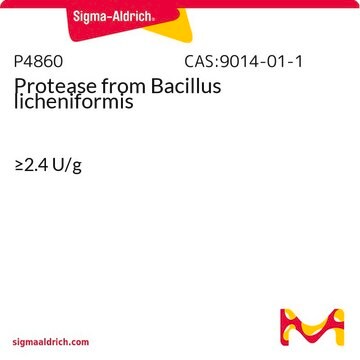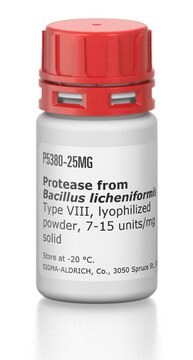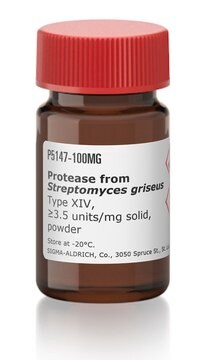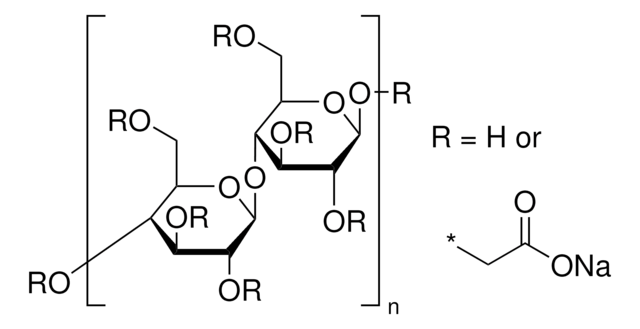P6236
Pyroglutamate Aminopeptidase from Pyrococcus furiosus
recombinant, expressed in E. coli, ~90% (SDS-PAGE), ≥5.0 units/mg protein
Sinonimo/i:
L-Pyrrolidone carboxyl peptidase
Autenticatiper visualizzare i prezzi riservati alla tua organizzazione & contrattuali
About This Item
Numero CE:
Numero MDL:
Codice UNSPSC:
12352204
NACRES:
NA.54
Prodotti consigliati
Ricombinante
expressed in E. coli
Livello qualitativo
Saggio
~90% (SDS-PAGE)
Stato
lyophilized powder
Attività specifica
≥5.0 units/mg protein
PM
24.072 kDa by amino acid sequence
28 kDa by SDS-PAGE
Condizioni di spedizione
dry ice
Temperatura di conservazione
−20°C
Categorie correlate
Descrizione generale
Pyroglutamate Aminopeptidase from Pyrococcus furiosus, also called the deblocking aminopeptidase, is a 42 kDa protein and belongs to aminopeptidase A family. It shares sequence homology with aminopeptidase in the active site, with conserved zinc and cobalt binding residues.
Applicazioni
Pyroglutamate Aminopeptidase, from Pyrococcus furiosus is a recombinant, thermostable aminopeptidase that is expressed in Escherichia coli. It is used to cleave pyroglutamic acid which allows analysis of N-terminal sequences of peptides.
The enzyme from Sigma has been used for the removal of pyroglutamate (pGlu) N-terminal blocking group, under reduced conditions, prior to N-terminal sequencing of purified cassiicolin.
Thermostable aminopeptidase that liberates N-terminal pyroglutamic acid from proteins and peptides prior to Edman degradation.
Azioni biochim/fisiol
Pyroglutamate Aminopeptidase (PGP 1) interacts with immunoglobulin, functions as inflammatory cytokine and modulates immune response. The levels PGP 1 is elevated during inflammation.
This enzyme is specific for N-terminal pyroglutamic acids. It cleaves the N-terminal pyroglutamic acid from proteins and peptides prior to Edman degradation. The optimal temperature range is 95 to 100 °C and the optimal pH range is 6.0 to 9.0.
Definizione di unità
One unit will hydrolyze 1 μmol of pyroglutamate p-nitroanilide per minute at pH 7.0 at 37 °C.
Stato fisico
Lyophilized powder containing sodium phosphate
Nota sulla preparazione
Reconstitute the vial of enzyme with 50 μl of 50 mM sodium phosphate, pH 7.0, with 10 mM DTT and 1 mM EDTA. The reconstituted solution should be stored at -20 °C.
Avvertenze
Danger
Indicazioni di pericolo
Consigli di prudenza
Classi di pericolo
Eye Irrit. 2 - Resp. Sens. 1 - Skin Irrit. 2 - STOT SE 3
Organi bersaglio
Respiratory system
Codice della classe di stoccaggio
11 - Combustible Solids
Classe di pericolosità dell'acqua (WGK)
WGK 3
Punto d’infiammabilità (°F)
Not applicable
Punto d’infiammabilità (°C)
Not applicable
Dispositivi di protezione individuale
Eyeshields, Gloves, type N95 (US)
Scegli una delle versioni più recenti:
Possiedi già questo prodotto?
I documenti relativi ai prodotti acquistati recentemente sono disponibili nell’Archivio dei documenti.
I clienti hanno visto anche
Frédéric de Lamotte et al.
Journal of chromatography. B, Analytical technologies in the biomedical and life sciences, 849(1-2), 357-362 (2006-11-23)
Cassiicolin, a phytotoxin produced by the necrotrophic fungus Corynespora cassiicola, was purified to homogeneity from a rubber tree isolate. The optimized protocol involves reverse phase chromatography followed by size exclusion chromatography, with monitoring of the toxicity on detached rubber tree
Pyroglutamate aminopeptidase 1 may be an indicator of cellular inflammatory response as revealed using a sensitive long-wavelength fluorescent probe
Gong Q, et al.
Chemical Science, 7(7), 4694-4697 (2016)
A Ultrasensitive Near-Infrared Fluorescent Probe Reveals Pyroglutamate Aminopeptidase 1 Can Be a New Inflammatory Cytokine
Gong Q, et al.
Advanced science (Weinheim, Baden-Wurttemberg, Germany), 5(4), 1700664-1700664 (2018)
New deblocking aminopeptidases from Pyrococcus horikoshii
Mori K and Ishikawa K
Bioscience, Biotechnology, and Biochemistry, 69(10), 1854-1860 (2005)
Marie Schaeffer et al.
Molecular and biochemical parasitology, 150(2), 318-329 (2006-10-10)
Pyroglutamyl peptidases I (PPI) are cysteine peptidases of the clan CF, family C15, which hydrolyse N-terminal l-pyroglutamyl residues (l-pGlu). The l-pGlu modification is a post-transcriptional modification that confers relative aminopeptidase resistance and, in some cases, is essential to the modified
Il team dei nostri ricercatori vanta grande esperienza in tutte le aree della ricerca quali Life Science, scienza dei materiali, sintesi chimica, cromatografia, discipline analitiche, ecc..
Contatta l'Assistenza Tecnica.












